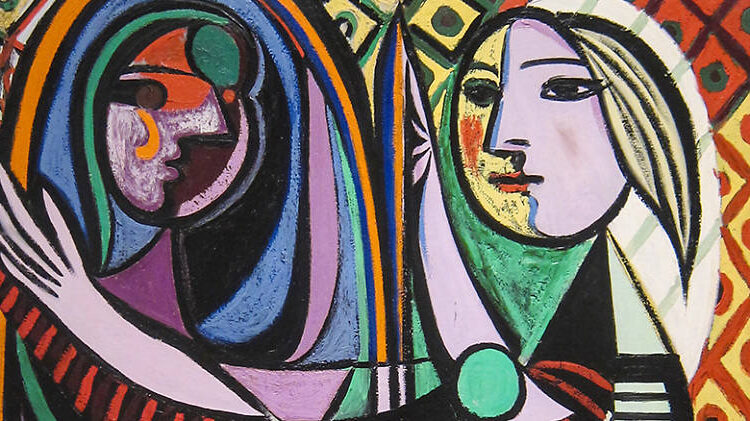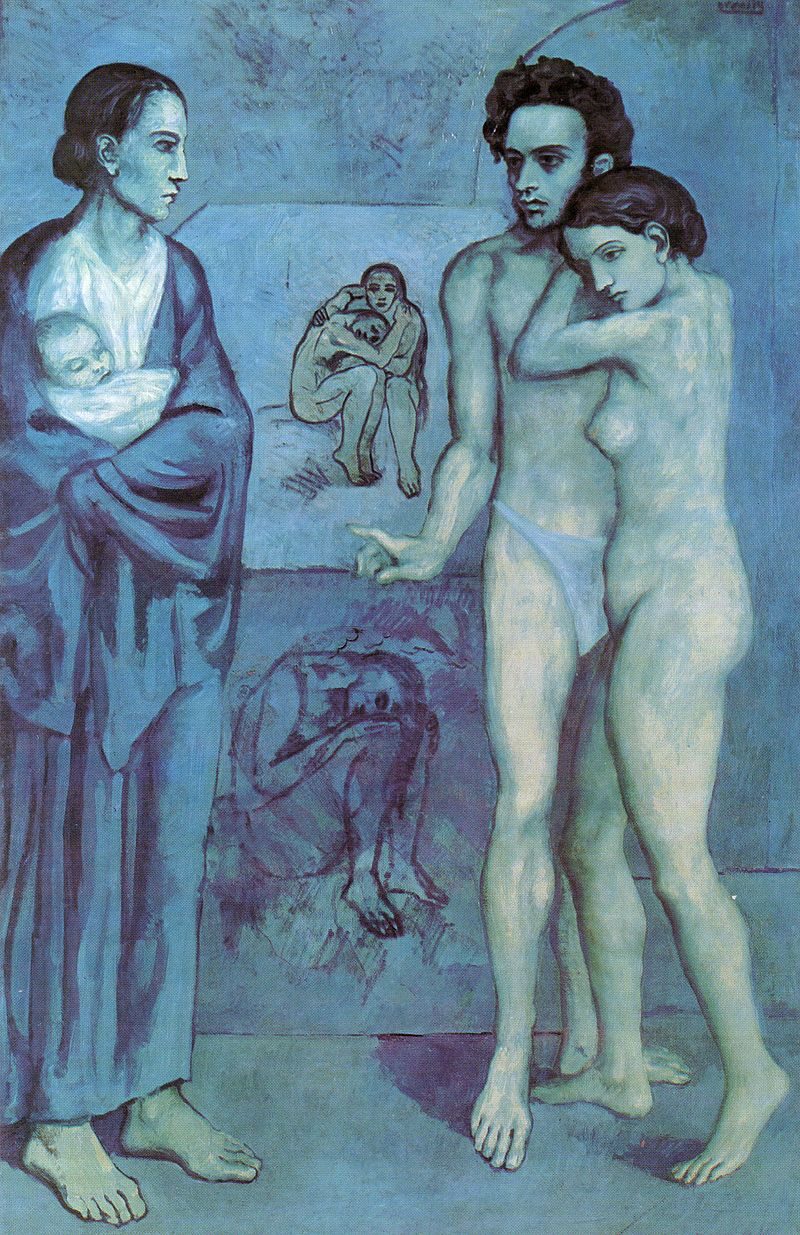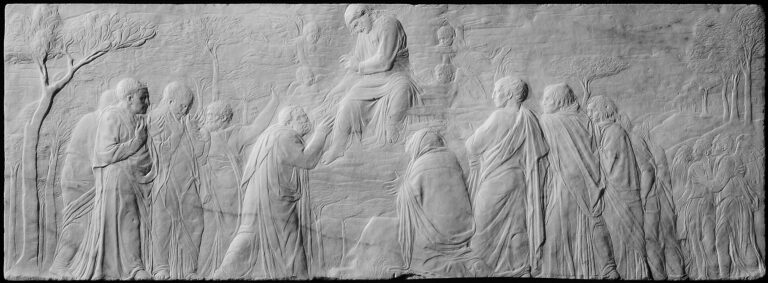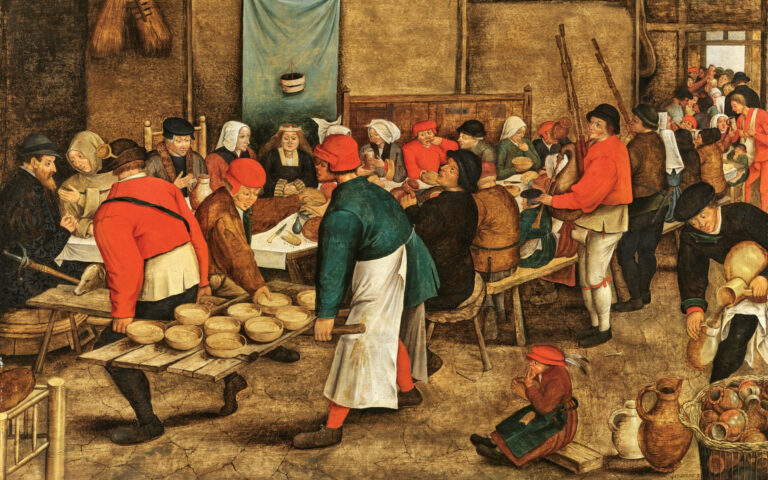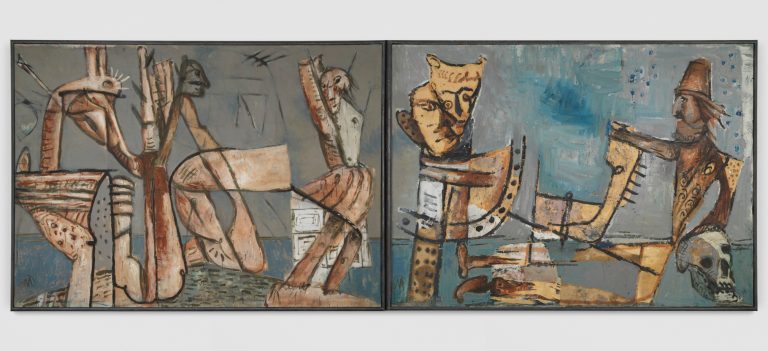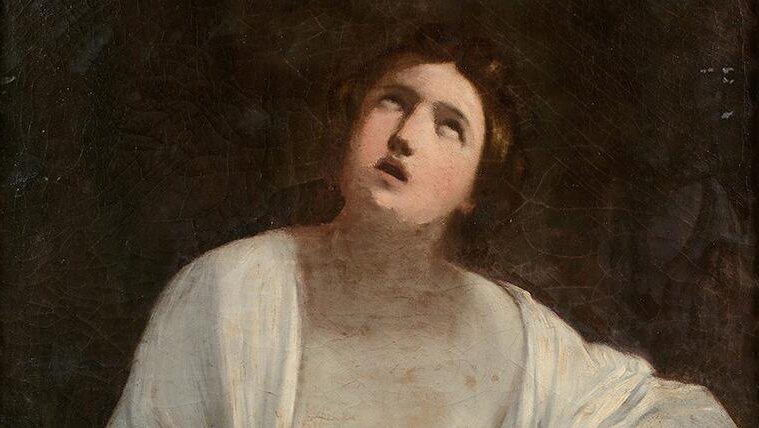Pablo Picasso Painter: The Pioneering Artist Who Revolutionized Modern Art
Born: 25 October 1881, Málaga, Spain
Death: 8 April 1973, Mougins, France
Art Movement: Cubism, Surrealism
Nationality: Spanish
Teacher: Don José Ruiz y Blasco (His Father)
Institution: Real Academia de Bellas Artes de San Fernando
Pablo Picasso Painter: The Pioneering Artist Who Revolutionized Modern Art
Life and Career of Pablo Picasso
Pablo Picasso is one of the most influential artists of the 20th century. His remarkable career spanned nearly eight decades. During this time, he created approximately 50,000 artworks and pioneered numerous art movements.
Early Life and Artistic Training
Pablo Ruiz Picasso was born on October 25, 1881, in Málaga, Spain. He showed extraordinary artistic talent from a young age. His father, Don José Ruiz Blasco, was a professor of drawing who recognized his son’s abilities early on.
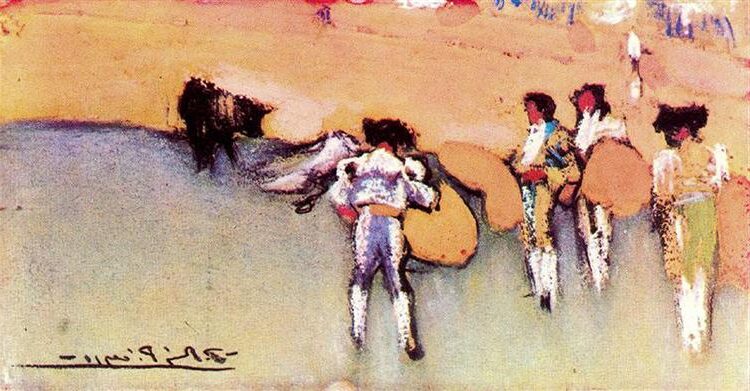
Bullfighters and Bull Waiting for the Next Move (1900) by Pablo Picasso
By age 13, Picasso’s skills had surpassed his father’s. He studied at the Academy of Fine Arts in Barcelona, where his father taught. In 1897, he continued his education at Madrid’s Royal Academy of San Fernando.
Unlike many artists, Picasso achieved recognition during his lifetime. His early works demonstrated remarkable technical ability and traditional training. However, he soon grew restless with academic conventions and began experimenting with different styles and techniques.
Blue and Rose Periods
From 1901 to 1904, Picasso entered his “Blue Period,” named for the blue tones that dominated his paintings. This phase began after his friend Carlos Casagemas committed suicide.
Works from this time depicted themes of poverty, loneliness, and human suffering. Notable paintings include “La Vie” (1903) and “The Old Guitarist” (1903-1904). The figures appeared elongated and somber, reflecting Picasso’s own emotional state during this period.
The “Rose Period” (1904-1906) followed when Picasso’s mood improved after meeting Fernande Olivier. His palette shifted to warmer pinks and oranges. His subjects included circus performers, acrobats, and harlequins, as seen in “Family of Saltimbanques” (1905).
Cubist Movement Co-Founder
Between 1907 and 1914, Picasso and French artist Georges Braque developed Cubism, revolutionizing Western art. This movement broke objects into geometric shapes, showing multiple viewpoints simultaneously.

Mule (1898–1899) by Pablo Picasso
Picasso’s “Les Demoiselles d’Avignon” (1907) marked a turning point, displaying African mask influences and fractured perspectives. This painting shocked even his closest artistic friends with its radical departure from tradition.
Analytical Cubism (1909-1912) featured monochromatic palettes and complex fragmentation. During Synthetic Cubism (1912-1914), Picasso incorporated collage elements and simpler forms, as seen in “Still Life with Chair Caning” (1912).
The movement’s influence extended beyond painting into sculpture, architecture, and design. Cubism challenged centuries of artistic tradition and paved the way for abstract art.
Classical Period and Surrealism
Following World War I, Picasso entered a neoclassical phase while continuing to work in Cubist styles. This “Classical Period” featured more naturalistic figures inspired by Mediterranean classicism and Roman art.
His marriage to Russian ballerina Olga Khokhlova in 1918 coincided with this shift. Paintings like “Two Women Running on the Beach” (1922) displayed solid, monumental figures with classical proportions.
By the late 1920s, Picasso developed connections with Surrealism. Though never formally joining the movement, he incorporated dreamlike, symbolic elements in his work. “The Three Dancers” (1925) shows this influence with its distorted figures and psychological intensity.
The Spanish Civil War profoundly affected Picasso, resulting in his masterpiece “Guernica” (1937), a powerful anti-war statement depicting the bombing of the Basque town.
Later Works and Final Years
After World War II, Picasso continued experimenting with style and medium. He developed a significant body of ceramic works at the Madoura Pottery in Vallauris, France, creating over 3,500 ceramic pieces.
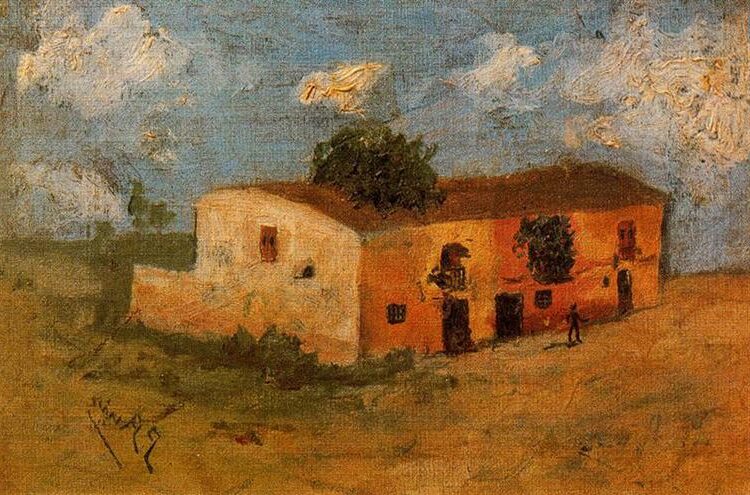
House in the Field (1893) by Pablo Picasso
During the 1950s and 1960s, he reinterpreted works by old masters like Velázquez and Delacroix. His “Las Meninas” series (1957) included 58 variations of Velázquez’s famous painting, demonstrating his analytical approach to art history.
Picasso’s late works featured a more simplified, expressive style with bold outlines and vibrant colors. He continued creating art until his death on April 8, 1973, at age 91 in Mougins, France.
Throughout his career, Picasso’s personal relationships influenced his art. He had numerous lovers and four children with three women.
Notable Works and Artistic Legacy
Pablo Picasso created thousands of works that revolutionized art in the 20th century. His innovative techniques and artistic vision continue to influence artists today, with his most famous pieces displayed in prestigious museums worldwide.
Les Demoiselles d’Avignon
Painted in 1907, “Les Demoiselles d’Avignon” marked a radical break from traditional painting. This work depicts five nude female figures with angular and fragmented forms. The women’s faces show influences from African masks and Iberian sculpture.
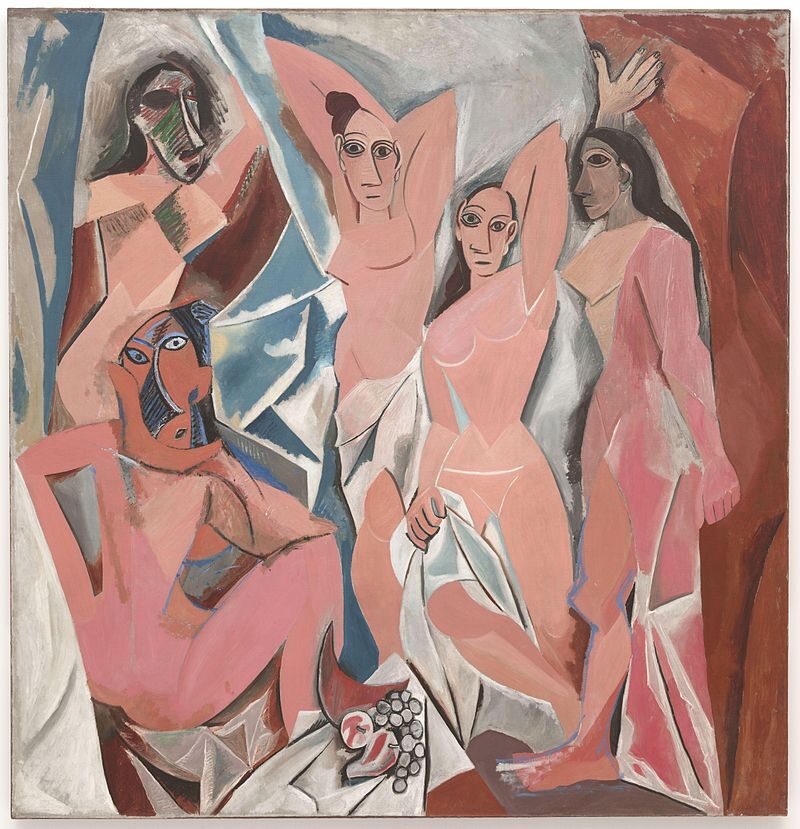

The painting shocked even Picasso’s closest artist friends. Many consider it the first truly Cubist painting, though it predates the formal Cubist movement.
The angular forms and revolutionary composition challenged conventional ideas about beauty and representation. Art historians often cite this work as the beginning of modern art.
The painting now resides in the Museum of Modern Art in New York City, where it attracts countless visitors yearly.
Guernica
“Guernica” (1937) stands as Picasso’s most powerful political statement. The large-scale painting (11 feet tall by 25.6 feet wide) depicts the bombing of Guernica, a Basque town in northern Spain, by Nazi Germany and Fascist Italy.
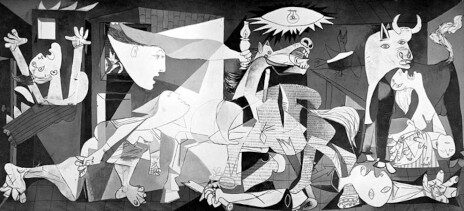
Guernica (1937) by Pablo Picasso
Created during the Spanish Civil War, the monochromatic painting uses stark black, white, and gray tones to convey the horror of war. The work features distorted figures in pain—a screaming woman, a dead baby, a wounded horse, and a bull.
Picasso refused to explain the symbolism, preferring viewers to interpret the meaning themselves. The painting traveled the world raising awareness about the Spanish Civil War.
“Guernica” now hangs in the Museo Reina Sofía in Madrid after Picasso requested it not return to Spain until democracy was restored.
The Weeping Woman
Completed in 1937, “The Weeping Woman” serves as a continuation of the suffering theme explored in “Guernica.” The painting portrays Dora Maar, Picasso’s lover and muse at the time.


The portrait uses vibrant colors and cubist techniques to capture intense emotion. The woman’s face appears shattered into sharp, angular fragments, with tears and a handkerchief prominently featured.
Picasso created numerous studies of weeping women, but this version is considered the most powerful. The distorted features express profound grief and anguish.
The painting exemplifies Picasso’s ability to convey extreme emotional states through formal distortion. It currently resides in the Tate Modern in London.
Influence on Modern Art
Picasso’s impact on modern art cannot be overstated. His co-creation of Cubism with Georges Braque fundamentally changed how artists approach representation and perspective.
His willingness to experiment with styles and techniques inspired generations of artists. Picasso moved freely between different artistic modes, demonstrating that artists need not commit to a single style.
Many art movements trace their roots to Picasso’s innovations:
- Abstract Expressionism
- Surrealism
- Conceptual Art
- Neo-Expressionism
Picasso’s practice of incorporating found objects into artwork influenced assemblage art and installation art. His ceramic works expanded the possibilities of that medium beyond traditional craft.
Artists today still study his approaches to form, color, and composition. His bold reinvention of artistic traditions continues to embolden artists to break conventions.
Museums and Permanent Collections
Picasso’s works appear in major museums throughout the world. The Musée Picasso in Paris houses the largest collection with over 5,000 works donated by his heirs.
The Museo Picasso in Barcelona features important early works and demonstrates his formative development. The museum occupies five medieval palaces in the city’s Gothic Quarter.
Other significant collections include:
| Museum | Location | Notable Works |
|---|---|---|
| Museum of Modern Art | New York | Les Demoiselles d’Avignon |
| Museo Reina Sofía | Madrid | Guernica |
| Tate Modern | London | The Weeping Woman |
| Picasso Museum | Málaga | Over 200 works in his birthplace |
The Guggenheim Museum in New York and Centre Pompidou in Paris also maintain substantial Picasso collections. His works regularly break auction records, with paintings selling for over $100 million.
Personal Life and Relationships

Massacre in Korea (1951) by Pablo Picasso
Pablo Picasso’s personal life was as colorful and complex as his artwork. His relationships with women, fellow artists, and political causes all influenced his creative output and shaped his public persona.
Marriages and Partnerships
Picasso married twice but had numerous significant relationships throughout his life. His first marriage was to Olga Khokhlova, a Russian ballerina with Sergei Diaghilev’s troupe, whom he wed in 1918. They had a son, Paulo, in 1921.
The marriage deteriorated in the late 1920s, and they formally separated in 1935, though they never divorced due to Picasso’s refusal to divide his assets.
In 1927, while still married to Olga, Picasso began a relationship with Marie-Thérèse Walter, who was just 17 years old when they met. She later gave birth to his daughter.
Picasso’s second marriage was to Jacqueline Roque. Between these marriages, he had several important relationships, including those with photographer Dora Maar and artist Françoise Gilot, who bore him two children: Claude and Paloma.
Friendships with Influential Artists and Writers
Picasso maintained strong connections with the artistic and literary elite of his time. His close friendship with Georges Braque led to their collaborative development of Cubism, revolutionizing modern art.
The poet Guillaume Apollinaire was another key figure in Picasso’s life, defending him during the controversy over stolen Louvre artifacts.
During his time in Paris, Picasso became part of an influential circle that included writers like Gertrude Stein, who was an early collector of his work and helped promote him in America.
His friendship with Jean Cocteau resulted in several theatrical collaborations, including designs for the ballet “Parade” with Erik Satie.
Political Involvement
Picasso’s political views leaned strongly to the left throughout much of his life. He joined the French Communist Party in 1944 and remained a member until his death.
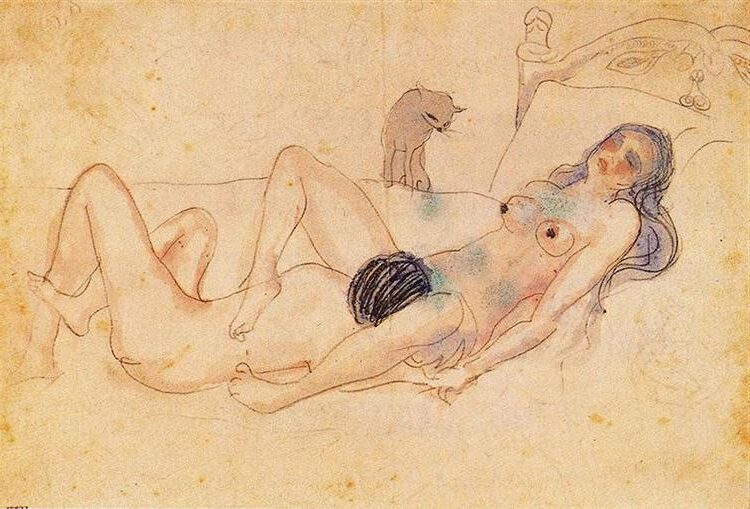
Two Nudes and a Cat (Deux nus et un chat) (1903) by Pablo Picasso
His masterpiece “Guernica” (1937) stands as his most powerful political statement, created in response to the bombing of the Basque town during the Spanish Civil War.
Picasso refused to return to Spain while Francisco Franco remained in power, living in self-imposed exile from his homeland.
During World War II, he remained in Paris under Nazi occupation, where he continued to create art despite being forbidden from exhibiting. His studio became a symbol of quiet resistance.
Frequently Asked Questions
Pablo Picasso revolutionized art with his innovative style and diverse artistic periods. His work broke traditional boundaries and influenced generations of artists across the world.
What are the defining characteristics of Pablo Picasso’s painting style?
Picasso’s style is characterized by bold experimentation and constant evolution. He frequently distorted forms and used multiple perspectives in a single image.
His work often featured geometric shapes, fragmented objects, and flattened picture planes. Picasso didn’t hesitate to abandon conventional beauty for expressive power.
He employed strong lines, vibrant colors, and simplified forms to convey emotion and meaning. His willingness to break artistic rules set him apart from his contemporaries.
How did Pablo Picasso’s work contribute to the development of the Cubist movement?
Picasso co-founded Cubism alongside Georges Braque around 1907. His painting “Les Demoiselles d’Avignon” (1907) is widely considered the first proto-Cubist work.
In Cubism, Picasso rejected single-point perspective in favor of showing objects from multiple viewpoints simultaneously. This revolutionary approach broke objects into geometric shapes and rearranged them in abstract form.
Picasso’s analytical Cubism phase (1909-1912) reduced subjects to overlapping planes and shapes. Later, his synthetic Cubism introduced collage elements and more colorful compositions.
Can you outline the different periods of Pablo Picasso’s artistic career and their significance?
Picasso had several distinct artistic periods, each with its own unique style and themes.
The Blue Period (1901-1904) featured somber blue tones depicting themes of poverty and human suffering. His Rose Period (1904-1906) introduced warmer colors with circus performers and harlequins as subjects.
The African-influenced Period (1907-1909) showed his fascination with African tribal masks, leading directly to Cubism. His Cubist period (1909-1919) revolutionized Western art with its radical approach to form and perspective.
Picasso’s Neoclassical Period (1918-1925) returned to more traditional forms. His Surrealist period (1925-1935) explored dreamlike imagery, while his later works (1935-1973) showed increasing expressionism and emotional intensity.
What influence did Pablo Picasso have on modern art and subsequent generations of artists?
Picasso shattered traditional artistic conventions, giving permission for future artists to experiment freely. His co-creation of Cubism fundamentally changed how artists approached representation.
He demonstrated that art could be conceptual rather than purely visual. This principle influenced movements like Abstract Expressionism, Minimalism, and Conceptual Art.
Picasso’s prolific output and willingness to reinvent himself repeatedly showed artists that continual evolution was possible. His political works like “Guernica” proved art could be both aesthetically innovative and socially powerful.
Which of Pablo Picasso’s paintings are considered his most iconic or groundbreaking works?
“Les Demoiselles d’Avignon” (1907) marked a radical break with tradition. It featured angular figures and fractured forms.
“Guernica” (1937) stands as his most famous political work. It depicts the bombing of a Basque town.
“The Weeping Woman” (1937) represents his powerful emotional expressionism. Meanwhile, “Girl Before a Mirror” (1932) exemplifies his exploration of identity and perception.
“Three Musicians” (1921) showcases mature synthetic Cubism. On the other hand, “The Old Guitarist” (1903-1904) remains one of the most recognizable works from his Blue Period. This piece captures human suffering with profound empathy.
How did Pablo Picasso’s personal life and historical context influence his art?
Picasso’s relationships with women often directly influenced his artistic style. New romantic partners frequently coincided with stylistic shifts in his work.
The Spanish Civil War and World War II profoundly affected his subject matter. “Guernica” responded directly to the bombing of the Spanish town, while his “Dove of Peace” became an enduring symbol.
His Spanish heritage remained evident throughout his career. Early poverty in Barcelona and later prosperity in France both shaped his perspectives and subject matter. They reflect his personal journey through rapidly changing historical contexts.

